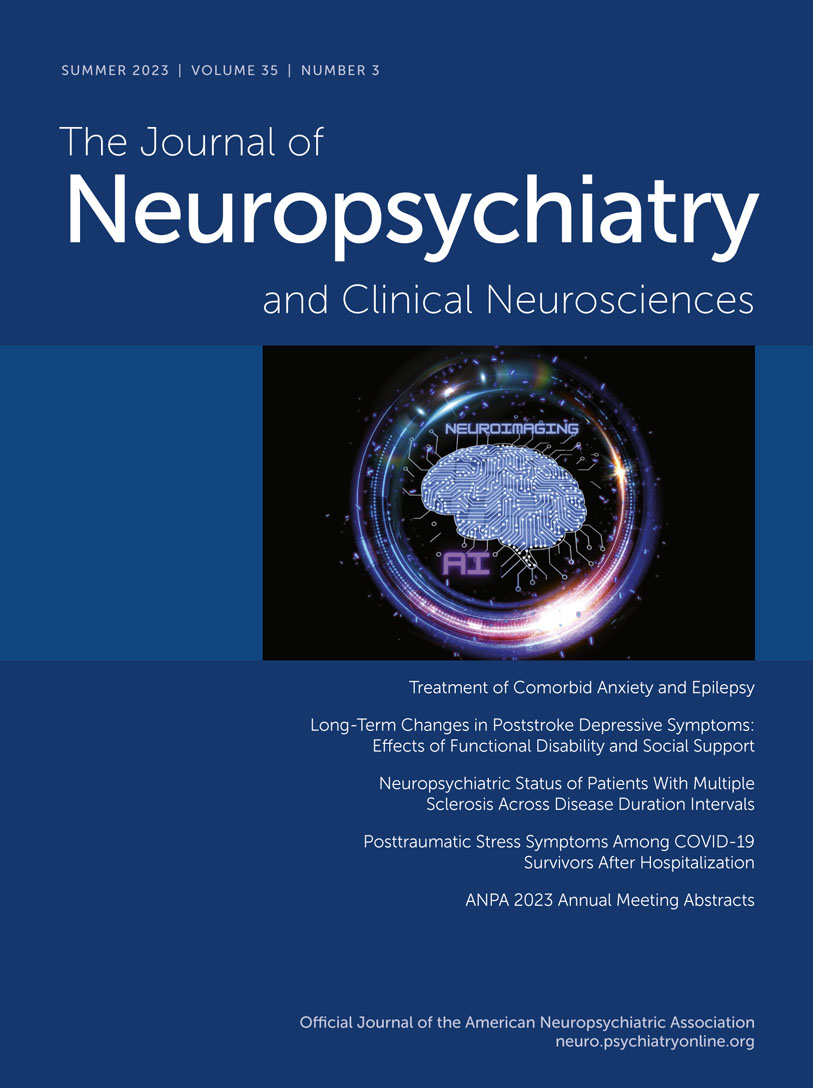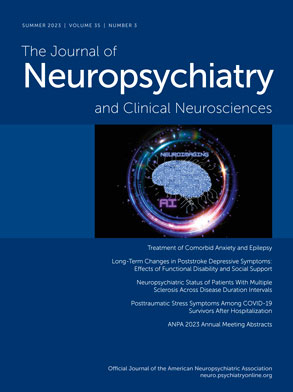These differences may also be caused by the various methods used to diagnose PSD. Although depression is usually diagnosed by a constellation of symptoms, some specific symptoms (e.g., loss of appetite, insomnia, fatigue, and concentration difficulties) may result from neurological disabilities, brain lesions, or comorbid diseases rather than from true depression in patients with stroke. Thus, there have been arguments regarding whether the diagnostic tools for depression used in psychiatric patients can be applied to patients with stroke (
7). Depressive symptoms may also change over time because functional capabilities or the status of the brain may change in stroke patients (
5). In addition, because functional disabilities may recover over time, and patients are more likely to be engaged with their previous occupations in the subacute or chronic stage of stroke, functional disabilities and social or familial support may have differential roles at different times (
8).
These issues have rarely been investigated, and it remains unclear whether specific depressive symptoms change over time in stroke patients. It also remains unknown whether specific symptoms are particularly affected by social support or functional disability in these patients. The purpose of this study was to investigate long-term changes in specific depressive symptoms of PSD and to study the effects of functional disabilities and social support on these specific symptoms.
Results
Baseline characteristics and clinical variables for this study population are summarized in Table S1 in the online supplement. Mean age of the patients was 61.9±11.7 years, and 86 (39%) of the patients were women. One hundred twelve patients (50%) were randomly assigned to the escitalopram group.
There were significant improvements in mRS scores (median [interquartile range]) from baseline to the LTP (baseline vs. 6 months vs. LTP: 4.0 [3.0–5.0] vs. 3.0 [2.0–4.0] vs. 1.5 [1.0–3.0], p<0.001) (
Table 1). The prevalence of PSD (baseline vs. 6 months, 51% vs. 36%, p=0.002), total MADRS score (mean±SD) (baseline vs. 6 months: 9.3±8.0 vs. 6.2±6.2, p<0.001), and all single-item scores, except “concentration difficulties,” “inability to feel,” and “suicidal thoughts,” significantly decreased from baseline to 6 months (
Table 1).
However, the prevalence of PSD (6 months vs. LTP, 36% vs. 45%, p=0.022), total MADRS score (6 months vs. LTP, 6.2±6.2 vs. 8.7±8.7, p=0.002), and single-item scores, including “reduced sleep,” “concentration difficulties,” “lassitude,” “inability to feel,” and “pessimistic thoughts,” increased from 6 months to the LTP. The other specific items, including “apparent sadness,” “reported sadness,” “inner tension,” “reduced appetite,” and “suicidal thoughts,” did not worsen from the 6-month poststroke follow-up assessment to the LTP assessment (
Table 1).
We then investigated the relationships between demographic characteristics, risk factors, and clinical variables obtained at baseline and the LTP and the total MADRS scores at the LTP in simple linear regression analyses (
Table 2). Variables with significant effects (p<0.05) included age, hypertension, hyperlipidemia, baseline NIHSS and MADRS scores, antidepressant use, recurrent stroke, mRS score, and low social support at the LTP. A multiple linear regression analysis performed after we adjusted for baseline demographic characteristics (age and sex) and statistically significant factors (p<0.05), including hypertension, hyperlipidemia, baseline NIHSS score, baseline MADRS score, antidepressant use, regular clinic visit, recurrent stroke, low social support, and poor functional outcome, showed that there were differential effects of low social support and poor functional outcome on each specific symptom item (
Table 3). Both low social support (standardized β coefficient=0.17, 95% confidence interval [CI]=0.06 to 0.29, standard error [SE]=1.09, t=2.91, p=0.004) and poor functional outcome (standardized β=0.41, 95% CI=0.28 to 0.54, SE=1.28, t=6.20, p<0.001) were significantly associated with the total MADRS score during the LTP. Poor functional outcome was associated with all single-item scores (standardized β values=0.18–0.43, all p<0.02) except “reduced sleep.” In contrast, low social support was significantly associated with “reduced sleep” (standardized β=0.20, 95% CI=0.06 to 0.34, SE=0.20, t=2.81, p=0.005) and “pessimistic thoughts” (standardized β=0.16, 95% CI=0.03 to 0.30, SE=0.19, t=2.36, p=0.019) but not with the other items.
Discussion
This study showed that the prevalence of PSD, total MADRS score, and mRS score decreased over time up to 6 months after a stroke. However, although the mRS score continued to decrease, the prevalence of PSD and the total MADRS score increased after 6 months.
This study is the first to analyze changes in specific depressive symptoms over time in patients with stroke. Our data on suicidal ideation are not reliable because patients with high scores on the suicidal thoughts scale were excluded from the main EMOTION study, a placebo-controlled trial, for ethical reasons; thus, these data will not be discussed here. We found that all the specific symptoms, except for “concentration difficulties” and “inability to feel,” improved from the baseline assessment to the 6-month poststroke assessment. Moreover, the symptoms “reduced sleep,” “concentration difficulties,” “lassitude,” “inability to feel,” and “pessimistic thoughts” were exacerbated between the 6-month poststroke period to the LTP.
Neurological or functional disability is one of the most important determinants of PSD (
1,
17). Interestingly, although mRS scores continuously improved over time, the total MADRS score and the single-item scores for specific symptoms worsened during the LTP in our study. There are several possible reasons for this observation. First, even if neurological deficits had improved, functional deficits still remained in these patients; the median mRS score during the LTP was 1.5. Thus, although the deficits became milder after the 6-month poststroke time point, long-lasting functional deficits may have produced an accumulation of negative psychological problems that were exacerbated when patients reengaged in their social occupation during the chronic stage of stroke. Second, the worsening of certain specific symptoms such as “concentration difficulties,” “inability to feel,” and “lassitude” may be attributed to changing brain status rather than psychiatric problems (
7). A previous study reported that the rate of apathy after stroke increased steadily over 5 years (
18), possibly associated with increasing brain vascular pathology over time. Because of the similarity between “apathy” and “concentration difficulties” or “inability to feel,” exacerbation of these symptoms may reflect neurological rather than psychiatric problems. This theory may explain why scores for items such as “concentration difficulties” and “inability to feel” did not improve from the baseline to the 6-month poststroke period. Unfortunately, this issue was not systematically explored with follow-up brain imaging in our study.
In addition, one of these symptoms, the item “lassitude,” may be a manifestation of “fatigue” rather than depression, and fatigue is quite common in patients with stroke. One study showed that approximately one-third of stroke patients experienced fatigue in the acute and subacute stages; the prevalence remained similar at 18 months after stroke (
19). Another study showed that although stroke characteristics were associated with fatigue in the acute and subacute stages, fatigue in the chronic stage was more closely associated with medical comorbidities, such as arthritis and obstructive sleep apnea (
20). Regardless of the explanation, our observation raises questions about the use of diagnostic tools for depression in stroke patients that contain items that may not reflect true depressive symptoms. Further studies are needed to determine whether these items should be excluded from diagnostic tools used to assess depression in patients with stroke.
Only a few studies have examined the long-term course of PSD. Our results are consistent with those of a previous study demonstrating that the prevalence of PSD decreased up to 12 months but increased after 3 years (
21). In contrast, the South London Stroke Register (SLSR) study showed that the prevalence of PSD did not increase until 5 years poststroke (
22). These differing results may be due to the different tools used in these studies. In the former study, PSD was defined according to DSM-III criteria for major depression, which includes items such as “poor appetite,” “insomnia,” “psychomotor agitation,” “loss of interest,” “fatigue,” and “diminished ability to think or concentrate.” These items, which may not represent pure depressive symptoms, are included in the MADRS, which was used in our study. In contrast, the Hospital Anxiety and Depression Scale used in the SLSR study did not include common somatic symptoms such as fatigue and insomnia (
23). This observation suggests that the assessment of the prevalence of PSD in the chronic stage of stroke may differ according to whether the diagnostic tools employed contain items that may be influenced by neurological deficits or changing brain status.
We found that a low level of social support and poor functional outcome were each independently associated with the total MADRS score during the LTP. However, their effects on single-item scores were significantly different. Poor functional outcome was associated with each of the specific symptoms except for “reduced sleep.” In contrast, low social support was associated with “reduced sleep” and “pessimistic thoughts.” Sleep disturbances are known to be associated with social support (
24,
25). The amount of support received by a patient is associated with increased satisfaction, an increased sense of meaning in life, and decreased depressive symptoms, which in turn are associated with the likelihood of sleeping soundly (
26). Social support may also promote the expression of positive emotions and trust from others through social networks (
27,
28).
In contrast, poor functional outcome was not associated with “reduced sleep.” It is known that sleep disturbances and depression are bidirectionally related. Considering the close relationship between depression and sleep, one possible hypothesis is that “reduced sleep” is a pure depressive or psychiatric symptom in stroke patients during the LTP. Previous national population studies have suggested that having lower income, being divorced or separated, and having no health insurance are associated with insomnia (
29,
30). Interestingly, these factors are all within the category of social support. Therefore, “reduced sleep” may be a pure depressive symptom associated mainly with low social support rather than a symptom related to physical disability or brain lesions.
This study has several limitations. First, health care systems are different in different countries; generalizing the results of this study may be difficult because only Korean patients were included. Second, since we examined social support only once during the LTP, its impact on patients’ mood before the LTP remains unknown. Third, in the main EMOTION trial, we excluded patients with a previous history of depression and those with strong suicidal ideation. Moreover, approximately one-third of patients did not participate in the current study, and the nonparticipants were older and had higher initial MADRS and NIHSS scores than those who did participate. Thus, the prevalence and severity of PSD may have been underestimated in our study. This is an inherent problem in depression research; patients with depression are difficult to include in the placebo group and are hesitant to participate in clinical trials (
31). However, these factors are unlikely to have influenced our main conclusion because the purpose of the current study was to elucidate the changes in single-item scores for specific depression-related symptoms and to identify associated factors in patients with stroke, rather than to assess the exact prevalence of PSD.

